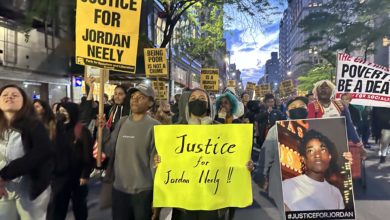Georgia inmates’ eight-day strike in December to improve prison conditions was a historic and powerful example that struggle is possible, even in the most unfavorable conditions.
 |
| Click here to download and distribute the poster |
The strike drew in six separate prisons, making it the largest such action in U.S. history. It
will undoubtedly have a large impact on the consciousness and
organization of the thousands of inmates who participated.
Beyond
the direct participants, the news of the strike could have a profound effect on prisoners elsewhere. If history is any guide, prison actions tend to come in waves, as inmate struggles in one facility lend confidence to those elsewhere. This is precisely why the
state and corporate media attempted to keep the strike quiet.
While the strike has ended, the inmates clearly got their point across. The newly formed Concerned Coalition to Protect Prisoners Rights was able to enter at least one prison on Dec. 20 and is currently preparing a report on prison conditions and on retaliatory measures taken against striking prisoners.
The very fact that advocates for the striking prisoners were allowed to enter even one prison to investigate conditions is a reflection of the inmates’ determination. The Georgia Correctional authorities had attempted to create a media blockade, giving out vague information, or none at all.
They also attempted to engage in a disinformation campaign against the strike, declaring they had “locked-down” the striking prisons, when those who were striking, were already refusing to leave their cells. The statements about lock-downs were meant to imply control, and minimize the impression on the outside that the strike was having an impact.
In fact, the striking inmates put the prison on
“lock-down” themselves, and the prison officials had lost a significant
amount, if not all, of their control for extended periods, across a
number of facilities.
The striking prisoners broke through two
of the biggest obstacles to political action faced by those in prison
systems: the repressive control of armed guards, and
vicious race and gang-based factionalism.
Anyone familiar with the U.S. penal system knows that violent division between various nationalities is a fact of prison life, creating a multi-tiered system of segregation amongst prisoners. Despite the message they attempt to send in cable news channel documentaries, prison officials prefer this state of affairs. Over and above anything else, it keeps cliques focused on hating each other, as opposed to focusing their hatred on the prison authorities and their oppressive practices.
Concomitantly with division, prisoners have very little control over their own persons. Forced to work for a pittance—or, in the case of Georgia, for no pay whatsoever—told when to wake up, sleep, eat, exercise, with whom they can communicate and when; prisoners are even further deprived of basic freedoms that aid the type of association crucial to building political movements.
The significance of this action by prisoners is that it even happened. The last 30 years have been characterized mostly by setbacks and defeats for the poor and working peopple—to the point that very few have ever witnessed, let alone experienced, collective action.
The prison strike in Georgia is one sign, however, that this can change, and quickly. Even under the most difficult conditions it is possible for human beings to connect based on their common oppressions, to invent ways to communicate and organize. As with the undocumented workers’ struggle, which exploded in 2006, apparent passivity one day can tranform into mass resistance the next.
For the Georgia prisoners’ struggle to move forward, solidarity and support is crucial from those on the outside. Progressives and revolutionaries should popularize their demands, and spread the word of their action, including to inmates elsewhere.
The prison population is overwhelmingly working-class, drawn largely from areas left destitute by de-industrialization, systematic discrimination and the drug epidemic. The time-honored slogan of the labor movement is needed for these brothers and sisters behind bars: An Injury to One is an Injury to All!






